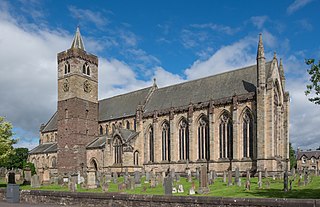James Stirling was a Scottish mathematician. He was nicknamed "The Venetian".
This article contains information about the literary events and publications of 1684.

Dunblane is a small town in the council area of Stirling in central Scotland, and inside the historic boundaries of the county of Perthshire. It is a commuter town, with many residents making use of good transport links to much of the Central Belt, including Glasgow and Edinburgh.

The Stirling council area is one of the 32 council areas of Scotland, and has a population of about 93,470. It was created in 1975 as a lower-tier district within the Central region. The district covered parts of the historic counties of Stirlingshire and Perthshire, which were abolished for local government purposes. In 1996 the Central region was abolished and Stirling Council took over all local government functions within the area.

Robert Leighton was a Scottish prelate and scholar, best known as a church minister, Bishop of Dunblane, Archbishop of Glasgow, and Principal of the University of Edinburgh from 1653 to 1662. He was "noted for his Christian piety, his humility and gentleness, and his devotion to his calling".

Dunblane Cathedral is the larger of the two Church of Scotland parish churches serving Dunblane, near the city of Stirling, in central Scotland.

Parliament House, located in the Old Town in Edinburgh, Scotland, is a complex of several buildings housing the Supreme Courts of Scotland. The oldest part of the complex was home to the Parliament of Scotland from 1639 to 1707, and is the world's first purpose-built parliament building.

Stirling Smith Art Gallery and Museum, formerly The Smith Institute, is an art and local history museum in Stirling, Scotland. The museum was founded in 1874 at the bequest of artist Thomas Stuart Smith.

The Durham University Library is the centrally administered library of Durham University in England and is part of the university's Library and Collections department. It was founded in January 1833 at Palace Green by a 160 volume donation by the then Bishop of Durham, William Van Mildert, and now holds over 1.6 million printed items. Since 1937, the university library has incorporated the historic Cosin's Library, founded by Bishop Cosin in 1669. Cosin's Library and the Sudan Archive held at Palace Green Library are designated collections under Arts Council England's Designation Scheme for collections of national and international significance; two collections at Durham University Oriental Museum, the Chinese collection and the Egyptian collection, are also designated.

Deanston is a village in the Stirling council area, Scotland, on the south bank of the River Teith east of Doune, in south-west Perthshire. It is a part of the parish of Kilmadock.

Alexander Leighton was a Scottish medical doctor and puritan preacher and pamphleteer best known for his 1630 pamphlet that attacked the Anglican church and which led to his torture by King Charles I.

St Blane's is a Church of Scotland church located in Dunblane, Scotland. The evangelical congregation is within the Church of Scotland's Presbytery of Stirling. The Gothic Revival church building opened in 1854 as the Free Church and is now a category B listed building.

The Andersonian Library is the university library of the University of Strathclyde in Glasgow, Scotland. Established in 1796, it is one of the largest of its type in Scotland.

Leipzig University Library, known also as Bibliotheca Albertina, is the central library of the University of Leipzig. It is one of the oldest German university libraries.

Amsterdam University Library is the library of the University of Amsterdam (UvA) and the Academic Medical Centre (AMC). The central complex of the Library is in the town centre at Singel, close to Heiligeweg and Koningsplein. The Library's Special Collections are housed nearby at Oude Turfmarkt, next to UvA's Allard Pierson Museum. The Library also has a large book depot in the grounds of the AMC, with over 40.5 kilometers of books and other materials. The foundation Friends of the Library of the University of Amsterdam regularly donates special manuscripts or rare editions to the library collection.

Orkney Library and Archive is a Scottish public library service based in Kirkwall, Orkney. Founded in 1683, Orkney Library is the oldest public library in Scotland. Its rules date from 1815. It has become known for its popular, humorous Twitter account.
Events from the year 1684 in the Kingdom of Scotland.

St Clement's Cottage is a building in the Scottish town of Dunblane, Stirling. Located in The Cross, immediately to the south of Dunblane Cathedral, it is a Category B listed structure dating to the mid-19th century. It adjoins Cathedral Cottage, on its northern side, also of Category B listed status.

Dunblane Museum is a historic building in the Scottish town of Dunblane, Stirling. Located in The Cross, immediately to the south of Dunblane Cathedral, it is a Category A listed building dating to the early 17th century.



















